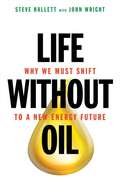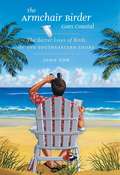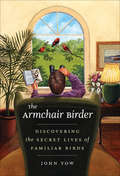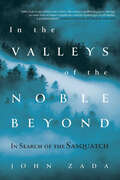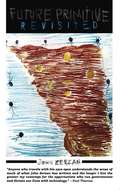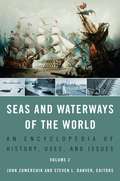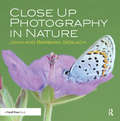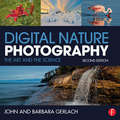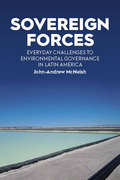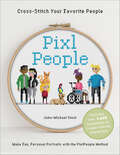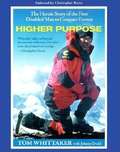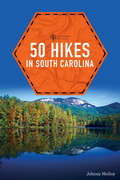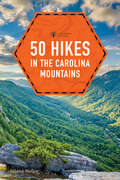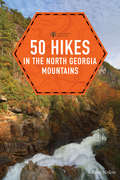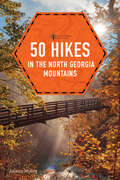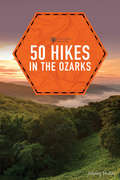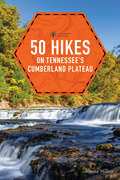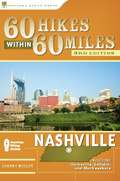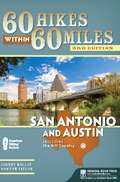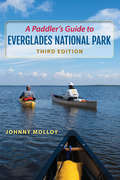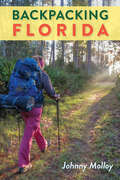- Table View
- List View
Whitetail Movement
by John WoottersThe very essence of deer hunting is the challenge of figuring where a given buck will be at a given time and trying to position oneself to intercept him. To do this, the hunter has to understand why whitetails move around within their home ranges and when, where they come from and where they go, and along which trails and corridors. He needs to know what moves deer and what prevents their movement, and how to take advantage of his conclusions.<P> With keen insight based on a half-century of experience, and with a genuine database yielding thousands of deer sightings under widely varying conditional parameters, John Wootters is uniquely qualified to share his knowledge on whitetail movement.
Life Without Oil: Why We Must Shift to a New Energy Future
by John Wright Steve HallettHallett (botany and plant pathology, Purdue U. ), who is joined by John Wright, an energy and environmental journalist, contends that oil and natural gas supplies will wane by the end of the century and that society has failed to see this problem and act on it. He describes the history of the world in terms of energy use, how the petroleum interval of the last century fits into larger civilization, and how the rise of civilizations has been a story of human access to increasingly powerful sources of energy and that problems with access to energy have led to societal collapse. He examines problems that are likely to occur in different countries over the next half century, effects on the global economy, and what can be done about them it by considering nuclear power, reconnecting communities, focusing on sustainable agriculture, and recognizing that the laws of ecology override the economy. Annotation ©2011 Book News, Inc., Portland, OR (booknews.com)
The Armchair Birder Goes Coastal
by John YowWith his distinctively witty, anecdotal, and disarming voice, John Yow now journeys to the shore and shares his encounters with some of the most familiar and beloved coastal birds. Out of his travels--from North Carolina's Outer Banks, down the Atlantic coast, and westward along the Gulf of Mexico--come colorful accounts of twenty-eight species, from ubiquitous beach birds like sanderlings and laughing gulls to wonders of nature like roseate spoonbills and the American avocets. Along the way, Yow delves deeply into the birds' habits and behaviors, experiencing and relating the fascination that leads many an amateur naturalist to become the most unusual of species--a birder.Seasonally organized chapters explore the improbable, the wonderful, and the amusing aspects of these birds' lives. Yow embellishes his observations with field notes, anecdotes, and stories from some of America's finest naturalists--including John James Audubon, Arthur Cleveland Bent, Rachel Carson, and Peter Matthiessen. Combining the endless fascination of bird life with the pleasure of good reading, The Armchair Birder Goes Coastal is the perfect companion for any nature lover's next trip to the beach.
The Armchair Birder's Omnibus Ebook
by John YowAvailable for the first time together in this Omnibus E-Book, The Armchair Birder's Omnibus brings together both of John Yow's delightful books into one convenient e-book.While birding literature is filled with tales of expert observers spotting rare species in exotic locales, John Yow reminds us in The Armchair Birder, that the most fascinating birds can be the ones perched right outside our windows. In thirty-five engaging and sometimes irreverent vignettes, Yow reveals the fascinating lives of the birds we see nearly every day. Following the seasons, he covers forty-two species, discussing the improbable, unusual, and comical aspects of his subjects' lives. Yow offers his own observations, anecdotes, and stories as well as those of America's classic bird writers, such as John James Audubon, Arthur Bent, and Edward Forbush. This unique addition to bird literature combines the fascination of bird life with the pleasure of good reading.In his follow-up volume The Armchair Birder Goes Coastal, Yow now journeys to the shore and shares his encounters with some of the most familiar and beloved coastal birds. Out of his travels--from North Carolina's Outer Banks, down the Atlantic coast, and westward along the Gulf of Mexico--come colorful accounts of twenty-eight species, from ubiquitous beach birds like sanderlings and laughing gulls to wonders of nature like roseate spoonbills and the American avocets. Along the way, Yow delves deeply into the birds' habits and behaviors, experiencing and relating the fascination that leads many an amateur naturalist to become the most unusual of species--a birder.
The Armchair Birder: Discovering the Secret Lives of Familiar Birds
by John YowBird lovers, take heart! While the birding literature is filled with tales of expert observers spotting rare species in exotic locales, John Yow's The Armchair Birder reminds us that the most fascinating birds can be the ones perched right outside our windows. In thirty-five engaging, humorous, and even irreverent essays, Yow reveals the fascinating lives of birds you probably already recognize and naturally want to know more about--because they're the ones you see nearly every day. Following the seasons of the year, Yow covers forty-two species, from the Carolina wren that rings in the springtime to the sandhill crane croaking high overhead at the end of winter. Leisurely and entertaining, the essays explore the improbable, unusual, and comical aspects of their subjects' lives--from the philandering of the ruby-throated hummingbird to the occasional dipsomania of the cedar waxwing. Rather than bare facts and field marks, The Armchair Birder offers observations, anecdotes, and stories--not only Yow's own, but also those of America's classic bird writers, such as John James Audubon, Arthur Bent, and Edward Forbush, experts who saw it all and wrote with wit and passion. With The Armchair Birder, backyard birders will take new delight in the birds at their feeders, while veteran check-listers will enjoy putting their feet up. All will applaud this unique addition to bird literature, one that combines the fascination of bird life with the pleasure of good reading.
In the Valleys of the Noble Beyond: In Search of the Sasquatch
by John ZadaA journalist travels through British Columbia exploring of one of the world’s most baffling mysteries?the existence of the Sasquatch.On the central and north coast of British Columbia, the Great Bear Rainforest is the largest intact temperate rainforest in the world, containing more organic matter than any other terrestrial ecosystem on the planet. The area plays host to a wide range of species, from thousand-year-old western cedars to humpback whales to iconic white Spirit bears.According to local residents, another giant is said to live in these woods. For centuries people have reported encounters with the Sasquatch—a species of hairy bipedal man-apes said to inhabit the deepest recesses of this pristine wilderness. Driven by his own childhood obsession with the creatures, John Zada decides to seek out the diverse inhabitants of this rugged and far-flung coast, where nearly everyone has a story to tell, from a scientist who dedicated his life to researching the Sasquatch, to members of the area’s First Nations, to a former grizzly bear hunter-turned-nature tour guide. With each tale, Zada discovers that his search for the Sasquatch is a quest for something infinitely more complex, cutting across questions of human perception, scientific inquiry, indigenous traditions, the environment, and the power and desire of the human imagination to believe in—or reject—something largely unseen.Teeming with gorgeous nature writing and a driving narrative that takes us through the forests and into the valleys of a remote and seldom visited region, In the Valleys of the Noble Beyond sheds light on what our decades-long pursuit of the Sasquatch can tell us about ourselves and invites us to welcome wonder for the unknown back into our lives.Praise for In the Valleys of the Noble Beyond“Books on supernatural phenomena typically steer one of two courses: tabloid gullibility or mean-spirited debunkery. Zada deftly tightropes between the two. . . . In the Valleys of the Noble Beyond is not really about sasquatch. It is about how we see what we want to see and don’t see what we’re not prepared to see. . . . A quirky and oddly captivating tale.” —Eric Weiner, Washington Post“An adventure story in the tradition of Paul Theroux and, in parts, Jon Krakauer. . . . Zada is a latter-day Henry David Thoreau or John Muir. . . . Searching for an elusive ape, Zada has a knack for meeting unforgettable humans.” —Peter Kuitenbrouwer, Globe and Mail“If people can believe in God, why not Sasquatch? Zada takes us through the temperate rainforest of British Columbia looking for both the hairy bipedal and the mythology and landscape surrounding it. Terrific nature writing with a furry twist.” —Kerri Arsenault, Orion
Future Primitive Revisited
by John Zerzan"Zerzan's writing is sharp, uncompromising, and tenacious." -- Derrick Jensen "John Zerzan's importance does not only consist in his brilliant intelligence, his absolute clearness of analysis and his unequalled dialectical synthesis that clarifies even the most complicated questions, but also in the humanity that fills his thoughts of resistance. Future Primitive Revisited is one more precious gift for us all."--Enrico Manicardi, author of Liberi dalla Civiltá (Free from Civilization) "Anyone who travels with his eyes open understands the sense of much of what you have written, and the longer I live the greater my contempt for the opportunists who run governments and dictate our lives with technology."--Paul Theroux "Of course we should go primitive. This doesn't mean abandoning material needs, tools, or skills, but ending our obsession with such concerns. Declaring for community, our true origin: personal autonomy, trust, mutual support in pursuit of all the joys and troubles of life. Society was a trap--massive, demanding, impersonal and debilitating from day one. So hurry back to the community, friends, and welcome all the consequences of such an orientation. The reasons for fear and despair will only multiply if we remain in this brutal and dangerous state of civilization."--Blok 45 publishing, Belgrade As our society is stricken with repeated technological disasters, and the apocalyptic problems that go with them, the "neo-primitivist" essays of John Zerzan seem more relevant than ever. "Future Primitive," the core innovative essay of Future Primitive Revisited, has been out of print for years. This new edition is updated with never-before-printed essays that speak to a youthful political movement and influential writers such as Derrick Jensen and Paul Theroux. An active participant in the contemporary anarchist resurgence, John Zerzan has been an invited speaker at both radical and conventional events on several continents. His weekly Anarchy Radio broadcast streams live on KWVA radio.
Twilight of the Machines
by John ZerzanThe mentor of the green anarchist and neo-primitive movements is back with his first book in six years, confronting civilisation, mass society, modernity and technoculture - both the history of its developing crisis and the possibilities for its human and humane solutions. As John Zerzan writes, 'These dire times may yet reveal invigorating new vistas of thought and action. When everything is at stake, all must be confronted and superseded. At this moment, there is the distinct possibility of doing just that. '
Seas And Waterways Of The World: An Encyclopedia Of History, Uses, And Issues
by John Zumerchik Steven L. Danver Steven Laurence DanverWritten at the level of high school and up, this two-volume reference offers an introduction to the use of the world's seas and waterways in history and during modern times, emphasizing the importance of seas and waterways to civilization. The reference's 134 entries are grouped in three sections. The section on the history of the world's seas and waterways contains entries on specific bodies of water around the world. The section on uses of the world's seas and waterways describes areas such as agriculture, coastal tourism, diving, oil and natural gas, sailing, surfing, passenger shipping, wave energy, and wind energy. The last section looks at issues pertaining to seas and waterways, such as cartography, dredging, lighthouses, laws and treaties, port operations, research vessels, and trade and transportation. Many entries contain b&w photos and maps. A chronology and a glossary are included. Zumerchik has written a previous reference work. Danver teaches history at National University.
Close Up Photography in Nature
by John and GerlachCapturing the grandeur of landscapes or mood of a certain natural light is challenging but often the simple details of a texture or color evade photographers most of all. In Close Up Photography in Nature, best-selling authors and nature photography pros, John and Barbara Gerlach, share the tips and techniques necessary to successfully photograph the beauty all around you. The Gerlachs are celebrated teachers who understand a photographer's mind so they begin this book with a brief overview of the fundamentals before delving into some of the more advanced and unique challenges of close up photography. Topics covered include: advanced flash techniques specific for close up shooting, as well as a discussion on focus stacking strategies and tilt-shift lenses for getting maximum depth-of-field. The Gerlachs also discuss their strategy of mixing flash with natural light when shooting close up, which opens up all sorts of photographic possibilities – opening up shadows, creating shadows, separating the subject from the background, reducing contrast between the subject and the background, improving the color rendition, shooting sharper images, and much more. This book will change the way you see the world as well as the way you share it through your work! the world through your work!
Digital Nature Photography: The Art and the Science
by John and GerlachIdentifying a beautiful image in nature is easy, but capturing it is often challenging. To truly seize the essence of a photograph shot out of the studio and in the world requires an artistic eye and impeccable set of photographic techniques. John and Barbara Gerlach have been teaching photographers how to master the craft of photographing nature and the outdoors through their workshops and best-selling books for more than twenty years. Now, equipped with brand new images to share and skills to teach, this celebrated photo team is sharing their latest lessons in the second edition of Digital Nature Photography. Notable revisions in this new edition include introducing the concepts of focus stacking and HDR, as well as expanded discussions of multiple exposure, wireless flash, RGB histograms, live view, shutter priority with auto ISO, hand-held shooting techniques, and the author’s equipment selections. The inspiring imagery in this book covers a broader range of subjects than before including ghost towns, the night sky, animals, and sports, in addition to the classic nature photographs we expect from this very talented author team. This book is a comprehensive guide to one of the broadest subjects in photography, explained and dymystified by two respected masters.
Sovereign Forces: Everyday Challenges to Environmental Governance in Latin America
by John-Andrew McNeishSovereignty is a significant force regarding the ownership, use, protection and management of natural resources. By placing an emphasis on the complex intertwined relationship between natural resources and diverse claims to resource sovereignty, this book reveals the backstory of contemporary resource contestations in Latin America and their positioning within a more extensive history of extraction in the region. Exploring cases of resource contestation in Bolivia, Colombia and Guatemala, Sovereign Forces highlights the value of these relationships to the practice of environmental governance and peacebuilding in the region.
PixlPeople: Cross-Stitch Your Favorite People
by John-Michael StoofCross-stitch your favorite people with this easy-to-follow and highly customizable methodGreat for new and experienced cross-stitchers, curious crafters, and handmade gift givers Personalize your PixlPeople with pets, hobbies, careers, facial expressions, and zodiac signs
Higher Purpose: Heroic Story of the First Disabled Man to Conquer Everest
by Johnny Dodd Tom WhittakerAs Tom Whittaker struggled to keep conscious the night of 27 November 1979, his thoughts focused on a singular plea: Please, don't let them take my legs. Earlier that evening, a drunk driver struck Tom's VW van on an isolated, snow-covered road in Idaho and shattered his legs -- and his dreams. When he awoke from emergency surgery, the 31-year-old mountaineer's right leg had been amputated at mid-shin and his right kneecap removed. Devastated, he pondered suicide. Finally it occurred to him: you don't need your lower leg to kayak. Seven months after the accident, Tom hobbled down to the south fork of the Payette River, and began paddling. In the years since then, Tom has not only taken his life back, he's taken his family, his fellow sportsmen, and hundreds of thousands of disabled and able-bodied people to the top of the world. In May 1998, Tom became the first amputee to summit Mount Everest. The climb and his inspirational story, as well as his work on behalf of disabled people around the world, have earned him the recognition as one of America's most courageous heroes.
How Did Humans Go Extinct?
by Paul Hoppe Johnny MarcianoLet’s learn about the most mystifying species to ever walk the Earth!“A clever . . . way to bring awareness to the very real threats to humanity posed by war, climate change, and capitalism. A compelling and unique dystopian sci-fi picture book for early school age readers, this is recommended for all collections.” —School Library JournalPlib is like every other Nøørfbløøk kid on Earth, except for one thing.He loves humans—those horrible, terrifying monsters who dominated the planet ten million years ago.Only one thing about the humans bothers Plib. What happened to them all? Did they turn the planet into an uninhabitable wasteland? Or did they turn on each other? Or did the humans die out because of something else they did—or didn’t—do?Find the answer in How Did Humans Go Extinct?
50 Hikes in South Carolina (Explorer's 50 Hikes)
by Johnny MolloyHikes and walks from the mountains to the Lowcountry Seasoned hiking author Johnny Molloy details 50 hikes of varied lengths and difficulties throughout verdant South Carolina, from the Chattooga River to the diverse terrain of the Midlands, including Congaree National Park, all the way to the Lowcountry, land of beaches and forgotten swamps and designated wildernesses. Specific emphasis is placed on the most scenic destinations and unique places that make the Palmetto State special. Each hike includes a helpful information section, trail map, trailhead directions, and stunning photographs, with intriguing commentary about the human or natural history along the way.
50 Hikes in the Carolina Mountains: Walks, Hikes, And Backpacking Trips From The Lowcountry Shores To The Midlands To The Mountains And Rivers Of Upstate
by Johnny MolloyA guide to 50 hikes and walks in both the Old North and Palmetto states. In South Carolina, explore from the Chattooga River at the Georgia state line to Jones Gap State Park; and, in North Carolina, journey from the Nantahala National Forest near Robbinsville in the southwest to the wildlands along the Blue Ridge Parkway in the northeast. This guide also includes hikes on the North Carolina side of the Great Smoky Mountains. Some hikes in this book take place on the great Appalachian Trail, the master path of the Appalachians.
50 Hikes in the North Georgia Mountains: Walks, Hikes And Backpacking Trips From Lookout Mountain To The Blue Ridge To The Chattooga River (Explorer's 50 Hikes #0)
by Johnny MolloyLace up your boots and explore the majestic mountains of Georgia Few hikers know this gem of a region as well as Johnny Molloy. He’ll take you to waterfalls, overlooks, gigantic trees, historic sites, and primitive wilderness in significant spots such as Tallulah Gorge, Springer Mountain, and the Chattooga River. In a region with an incredible wealth of hiking options, Molloy outlines 50 of the most worthwhile trails, providing options for day, overnight, and multi-day hikes for explorers of every experience level. In this beautiful and fully updated third edition of 50 Hikes in the North Georgia Mountains, as with all the books in the 50 Hikes series, you’ll find clear and concise directions, easy-to-follow maps, and expert tips for enjoying every moment of your hike—whether you’re looking for sublime mountaintop views, peaceful walks through nature, or your next great challenge—all in a gorgeous, full-color design.
50 Hikes in the North Georgia Mountains: Walks, Hikes And Backpacking Trips From Lookout Mountain To The Blue Ridge To The Chattooga River (Explorer's 50 Hikes Ser. #0)
by Johnny MolloyLace up your boots and explore the majestic Georgia wilderness with this fully revised and updated guide! Few hikers know the North Georgia Mountains as well as Johnny Molloy. In 50 stunning trails, he’ll take you to waterfalls, overlooks, gigantic trees, historic sites, and landmarks such as Tallulah Gorge, Raven Cliff Falls, and the Chattooga River. In a region with an incredible wealth of hiking options, Molloy outlines his picks for the most worthwhile routes, providing options for day, overnight, and multi-day hikes for explorers of every skill level. This fully updated 4th edition of 50 Hikes in the North Georgia Mountains features 5 brand new trails, detailed maps, clear and concise directions, and expert tips for enjoying every moment of your hike—whether you’re looking for sublime mountaintop views, peaceful walks through nature, or your next great challenge. Including full-color photographs and maps, this is the perfect book to help you plan the ultimate Georgia outdoor adventure!
50 Hikes in the Ozarks (2nd Edition) (Explorer's 50 Hikes)
by Johnny MolloyDay hikes and overnights in the breathtaking Ozark Plateau Witness the natural majesty of the Ozarks with this complete and thorough guide to America’s most expansive and beautiful mountain ranges. Seasoned hiking expert Johnny Molloy maps out the best trails in the region, one for every level of hiker. Hikes include: Fort Smith State Park Morgan Mountain Spring Creek and Moccasin Spring Buffalo Wilderness As with all the books in the 50 Hikes series, you’ll find clear and concise directions, easy-to-follow maps, and expert tips for enjoying what each hike has to offer—whether it’s rejuvenating fresh water springs, scenic riverways, or serene glades.
50 Hikes on Tennessee's Cumberland Plateau: Walks, Hikes, And Backpacks From The Tennessee River Gorge To The Big South Fork (Explorer's 50 Hikes #0)
by Johnny MolloyWalks, hikes, and backpacking trips from the Tennessee River Gorge to the Big South Fork Tennessee’s Cumberland Plateau, a wide tableland cut with a dizzying array of deep gorges, is a geological wonderland. It is a place to behold and savor. This updated second edition covers hikes from the Big South Fork National River and Recreation Area near Kentucky to the fascinating Walls of Jericho astride the Alabama state line; from the thousand-foot gorge cut by the mighty Tennessee River down Chattanooga way to the watery beauty of Virgin Falls by Sparta. Specific emphasis is placed on the most scenic destinations and the unique places that make the plateau so special, places like the Great Stone Door, with its sandstone formations and vertical rock walls, and Cumberland Mountain State Park, with its ancient trees and evidence of ancient human history. Also included are comprehensive maps for each hike, scenic photos, and a hikes-at-a-glance table that makes choosing your desired hike a breeze.
60 Hikes Within 60 Miles: Nashville
by Johnny MolloyNashville may be the capital of country music, but it's also home to some splendid hiking trails. This guide offers trekkers of all ages and fitness levels a variety of day hikes throughout middle Tennessee, from historical hikes like the Outdoor Confederate Earthworks Walk to great recreational trails such as the Couchville Lake Loop. Maps, directions, and trail details are included for each hike.
60 Hikes Within 60 Miles: San Antonio and Austin
by Johnny Molloy Tom TaylorThe San Antonio area is perhaps the most picturesque spot for hiking in the Lone Star State. With this new edition in the best-selling 60 Hikes Within 60 Miles series, all these visually stunning and ruggedly charming routes are at the traveler's fingertips. This handy guide helps San Antonio and Austin natives get back into nature without going out of town. Extensive at-a-glance information makes it easy to choose the perfect hike based on length, difficulty, scenery, or on a specific factor such as hikes good for families, runners, or birding. Each trail profile includes maps, directions, driving times, nearby attractions, and other pertinent details.
A Paddler's Guide to Everglades National Park
by Johnny MolloyWhether forging uncharted territory or slipping along marked canoe trails, get ready to experience more than 400 miles of creeks, bays, marshes, and the Gulf of Mexico. This indispensable guide for the ultimate adventure by canoe or kayak now includes GPS coordinates and twelve new paddle routes.
Backpacking Florida
by Johnny MolloyThe essential guide to Florida’s best overnight hiking trips From the coastal bluffs of the Panhandle to the wild Everglades, Backpacking Florida features 40 overnight trail adventures covering a total of 600 miles across the state. Expert outdoorsman Johnny Molloy provides readers with the tools and information they need to unplug and experience Florida’s amazing variety of ecosystems up close. Destinations in this guide range from well-known, “must-do” spots like Juniper Prairie Wilderness, Rice Creek Conservation Area, and the Blackwater River State Forest to undiscovered gems like Jennings State Forest, Ocklawaha Prairie Restoration Area, and Bonnet Pond. Trails are categorized by region, difficulty, and length, from 3-mile family treks to 50-mile larger-than-life excursions, resulting in a useful guide for both novice and experienced backpackers. For every trail, Molloy includes a map and mileage chart and explains how to get to the trailhead, where the campsites are, and what hikers will see along the way. Readers will also find helpful advice on topics such as selecting a campsite and food for the trail. Backpacking Florida is an invaluable resource for planning and enjoying the perfect Florida outdoor adventure.

